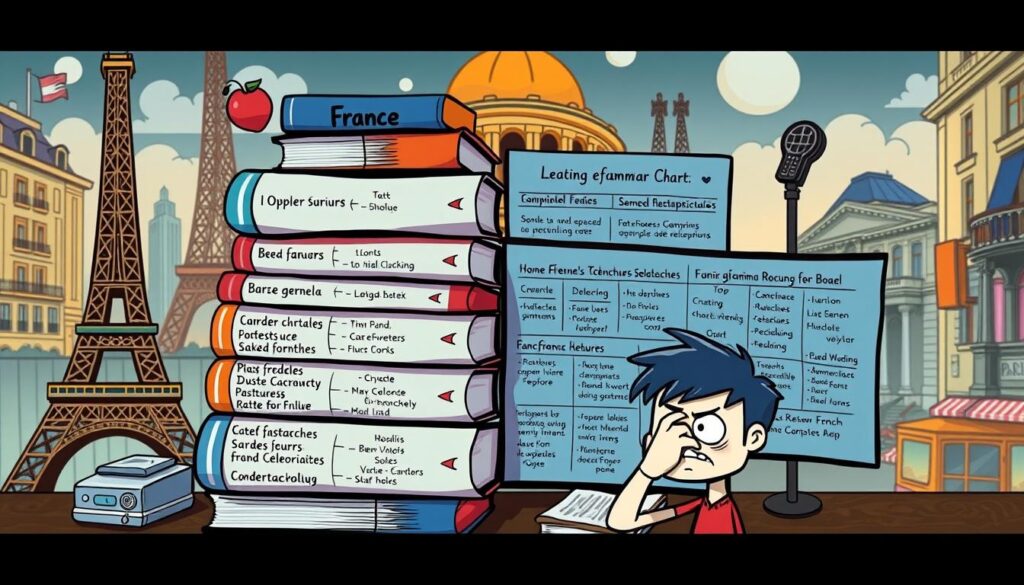There are many tools for learning languages, but choosing the right one is key. Duolingo has become popular among those wanting to learn French. It’s known for its fun learning style and teaching basic French words and sentences.
Duolingo stands out not just because it’s free. People love its easy access and how you can learn anytime. While fun characters and games make learning exciting, it’s important to look at how well it teaches French. Users like the rewards and various activities, but they note a gap in conversation practice and cultural learning.
To really learn French, you can’t just stick to the basics. Experts say you should also talk with native speakers. Duolingo offers over 200 lessons to get you started with French. However, to fully understand the language, you need to go beyond the app. Meeting and talking to people who speak French fluently is important.
Understanding Duolingo’s Approach to French Learning
When you start learning French with Duolingo, you embark on a new way of language learning. This platform changes how we see and dive into languages. It’s famous for its game-like approach, making learning French on Duolingo exciting. The lessons range from basic words to more complex grammar.
Exploring the Gamified Learning Experience
Learning on Duolingo is like playing a game. This method, called ‘gamified learning,’ helps students remember more. You meet friendly characters and get rewards as you move forward. This keeps learning fun and effective. Each lesson has different activities, such as matching pictures and translating phrases. This variety helps strengthen your vocabulary and grammar skills.
Structure of Duolingo’s French Curriculum
Duolingo’s French lessons start with simple hellos and common words. Then, they move to more complicated sentences and grammar. There are over 200 lessons, each building on the previous. Lessons are short—about 15 minutes. This keeps learners focused and not overwhelmed.
Adaptability to Individual Learning Styles
One top perk of Duolingo is how it fits various learning styles. You can learn at your pace, fast or slow. It lets you choose how long to study each day. Your lessons can match your schedule and how you like to learn. This flexibility and the short, engaging lessons make Duolingo a great option compared to other apps.
To truly understand French, beyond just the basics, you need more than Duolingo. It’s great for starting out, but talking with native speakers or learning from a French teacher helps too. You need these to become fluent and get the full picture of the language.
Analyzing the Benefits of Using Duolingo for French
Looking at a Duolingo French review, one sees many benefits, especially for beginners. Duolingo’s design makes learning French fun and successful. This approach suits all starting levels.
Accessible and User-Friendly Interface
The benefits of using Duolingo for French start with its easy-to-use platform. Whether it’s on computer or mobile, navigating the app is a breeze. Characters are friendly, and the design is straightforward. This makes the journey simpler for Duolingo for beginners in French.
Motivation Through Rewards and Streaks
Motivation is crucial for language studies, and Duolingo knows it. By earning ‘lingots’ and keeping up daily streaks, learners stay on track. This game feature keeps users coming back, ensuring steady progress.
The Diversity of Interactive Exercises
With Duolingo, learning is active, not passive. It has speaking, listening, reading, and writing exercises. They help create a well-rounded experience. Higher-level stories add real-world practice, raising confidence and skills.
The advantages of using Duolingo for French include building a strong language foundation while having a great time. It’s perfect for beginners and those refreshing their skills. Still, for deeper learning, consider mixing it with conversations with native speakers or other resources.
Comparing Free vs Paid Versions of Duolingo
When you start learning French online, choosing between Duolingo’s free or paid versions is big. We’ll look at what each offers, especially how Duolingo stacks up against traditional French.
Evaluating the Free Version and Its Features
The free Duolingo version comes with many learning tools but includes ads. You get to translate, listen, and enjoy interactive stories. Yet, keeping a learning streak can be tough without buying streak freezes to save your progress.
Distinguishing Between Super Duolingo and Duolingo Max
Super Duolingo offers an ad-free experience and lets you choose custom learning paths. It costs less than six euros a month. This plan even includes a monthly streak repair for free, helping you stay on track.
Duolingo Max adds an AI chatbot for better learning. This feature is for iOS users and makes it feel like you have your own French tutor.
| Feature | Free Duolingo | Super Duolingo | Duolingo Max |
|---|---|---|---|
| Price (per month) | Free with ads | Less than 6 euros | Part of Super subscription |
| Streak Repair | Purchase needed | 1 free per month | 1 free per month |
| Custom Learning Paths | Not Available | Available | Available |
| Ads after lessons | Yes | No | No |
| Access to AI Chatbot | No | No | Yes, for iOS users |
Whether you’re starting or seriously into learning French, Duolingo has options for all. Your choice depends on how deeply you wish to dive into the language. It’s about balancing the need for convenience with cost.
Assessing Duolingo’s Efficacy in Grammar and Vocabulary
Duolingo French learning effectiveness shows varied results in grammar and vocabulary learning. It struggles with complex grammar and French nuances. This analysis uses data to compare Duolingo with traditional learning.
A study of 225 US Duolingo users showed interesting findings. They achieved an Intermediate Low in reading and Novice High in listening. These levels are equal to what university students reach by their fourth semester. This might boost confidence in Duolingo’s language learning effectiveness for self-taught students.
| Language Skill | Proficiency Achieved | Comparable Traditional Study Outcome |
|---|---|---|
| Reading | Intermediate Low | End of fourth semester |
| Listening | Novice High | End of fourth semester |
| Speaking | Data Unavailable | Typically higher in immersive settings |
Duolingo does well in reading and listening areas. But, it doesn’t always cover grammar fully or modern spoken French. Its teaching style uses example sentences rather than clear grammar rules. For near-fluency goals, users might need extra materials.
Evaluating Duolingo in French learning needs continuous user feedback and data analysis. Duolingo uses these methods to improve its courses and boost learning and satisfaction. It focuses on ensuring users learn and apply vocabulary and grammar in real life.
For those with specific goals, Duolingo provides a strong base. Yet, for finer points and higher fluency, more resources are recommended. Duolingo is a great start to learning a language. But reaching high proficiency in French may require more diverse tools.
Identifying the Drawbacks of Duolingo French Learning
The Duolingo French review points out some cool ways to learn. But there are downsides, especially compared to old-school methods. For those seeking deep conversational skills, it might fall short in some areas.
Limited Real-world Conversation Practice
Duolingo is great for learning new words, as research by Kusumadewi and Widyastuti (2018) shows. Yet, knowing a lot of words doesn’t mean you can chat easily in real life. This issue comes from its game-like setup. It’s fun, but it doesn’t fully mimic daily speech.
Users also notice lessons can feel random, lacking clear dialogue skills for real-life chats. When we look at Duolingo vs traditional French learning methods, old-school ways often focus on practical conversations.
Insufficient Cultural Context in Lessons
A big miss is the lack of culture in lessons. Understanding the culture behind a language deepens learning and helps use it right. Traditional learning usually blends cultural insights with language lessons, something not as strong in Duolingo.
The app’s design encourages memorizing set phrases without room for synonyms or different ways to express the same idea. This could limit how freely and creatively users can use French, unlike in traditional settings.
Adding Duolingo to your study plan? It’s smart to pair it with other methods. Try talking more, reading, and diving into the culture to fill the gaps. Many users and studies suggest this mix boosts Duolingo’s effectiveness.
If you’re curious about how well Duolingo teaches French, check out this detailed review. A blend of Duolingo and classic methods might be your best shot at mastering French.
| Feature | Duolingo | Traditional Methods |
|---|---|---|
| Engagement Type | Gamified, App-based | Personal, Interactive |
| Vocabulary Building | Structured, repetitive | Contextual, Flexible |
| Cultural Learning | Limited | Extensive |
| Real-world Application | Minimal | Significant |
Complementing Duolingo with Other French Learning Resources
Exploring the Duolingo French course, it’s clear that Duolingo alone might not be enough for fluency. Including other resources in your learning can help. Programs like Mondly, at $10 a month, and Rosetta Stone, for $12 a month, offer different ways of learning.
Adding personal interaction is crucial too. Talking with native speakers and getting a tutor provides feedback that apps can’t. Live lessons are tailored to your needs, helping you understand conversational French better. While Duolingo is improving with features like Duolingo Stories, adding various methods enriches your learning. Adding Pimsleur, which costs $15 a month and focuses on speaking, is a great idea.
Using different media to immerse in French is also key. Fluent charges $7 a month and opens new learning paths. Lirica, at $9 a month, teaches through music. VR from Immerse, at $24 a month, offers virtual real-world experiences. Taking breaks is vital, as staying motivated can be challenging. But, mixing Duolingo with other tools keeps the learning exciting and aids in mastering French.


